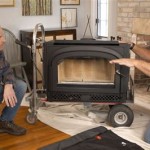Types of Gas Fireplaces: A Comprehensive Guide
Gas fireplaces have become a popular alternative to traditional wood-burning fireplaces, offering convenience, efficiency, and a variety of aesthetic options. They provide the ambiance and warmth of a fireplace without the hassle of sourcing, storing, and burning wood. Understanding the different types of gas fireplaces available is crucial for selecting the right model for individual needs and preferences. This article explores the major categories of gas fireplaces, highlighting their features, benefits, and installation considerations.
Direct Vent Gas Fireplaces
Direct vent gas fireplaces represent a significant advancement in fireplace technology. These units are sealed combustion systems, meaning they draw combustion air from outside the home and vent exhaust gases directly outdoors through a coaxial vent pipe. This pipe, which consists of one pipe inside another, allows for both air intake and exhaust to occur simultaneously. The inner pipe expels combustion byproducts, while the outer pipe draws in fresh air for the burning process. This sealed system prevents indoor air from being used for combustion, resulting in improved energy efficiency and indoor air quality.
One of the primary advantages of direct vent fireplaces is their versatility in installation. Unlike traditional fireplaces that require a chimney, direct vent models can be vented horizontally through an exterior wall or vertically through the roof. This flexibility allows for installation in a wider range of locations, including rooms without existing chimneys. Direct vent fireplaces are also known for their safety features. The sealed combustion system reduces the risk of carbon monoxide poisoning, as all combustion byproducts are vented directly outside. Furthermore, the glass front of the fireplace remains relatively cool to the touch, minimizing the risk of burns.
Direct vent fireplaces are available in various styles, including traditional, contemporary, and linear designs. They can be configured as freestanding units, inserts for existing fireplace openings, or built-in models for new construction. The flame appearance can also be customized with realistic log sets, decorative glass, or stones. The efficiency ratings of direct vent fireplaces are typically high, often exceeding 70%, making them a cost-effective heating option for supplemental heat. Proper installation by a qualified technician is essential to ensure safe and efficient operation.
Vent-Free (Ventless) Gas Fireplaces
Vent-free gas fireplaces, also referred to as ventless fireplaces, operate without the need for an external venting system. These units burn natural gas or propane and release the combustion byproducts directly into the room. They are designed to burn fuel very cleanly, minimizing the production of carbon monoxide and other pollutants. Vent-free fireplaces are equipped with an Oxygen Depletion Sensor (ODS) that monitors the oxygen level in the room. If the oxygen level drops to an unsafe level, the ODS automatically shuts off the fireplace, preventing carbon monoxide buildup.
The primary advantage of vent-free fireplaces is their ease of installation and affordability. Since they do not require venting, they can be installed in almost any room, including basements and bedrooms. This makes them a convenient option for adding supplemental heat to areas that are difficult to heat with central heating systems. Vent-free fireplaces are also relatively inexpensive compared to direct vent models, making them an attractive option for budget-conscious homeowners.
Despite their convenience, vent-free fireplaces have some limitations. Because they release combustion byproducts into the room, they are subject to strict installation regulations and may be prohibited in some jurisdictions. Many manufacturers recommend or require a certain amount of square footage in the room where the fireplace is installed to ensure adequate ventilation. Additionally, vent-free fireplaces may produce a slight odor during operation and can increase humidity levels in the room. Regular maintenance, including cleaning the burner and inspecting the ODS, is crucial for safe and efficient operation. While vent-free models are designed with safety features, proper installation and adherence to manufacturer guidelines are paramount.
B-Vent Gas Fireplaces
B-Vent gas fireplaces, also known as natural vent fireplaces, represent a middle ground between direct vent and vent-free models. These fireplaces use a single-wall vent pipe (B-vent) to exhaust combustion gases vertically through the roof. Unlike direct vent fireplaces, B-Vent models draw combustion air from inside the room. The B-vent pipe relies on natural convection to carry the exhaust gases out of the building.
B-Vent fireplaces offer a more traditional fireplace appearance and are often used to replace existing wood-burning fireplaces. They provide a realistic flame and can be fitted with a variety of log sets and decorative options. While they require a chimney or vent system, the venting requirements are less stringent than those of traditional wood-burning fireplaces, making them easier to install in some situations.
The efficiency of B-Vent fireplaces is generally lower than that of direct vent models. Because they draw air from inside the room and vent it outside, they can contribute to heat loss. B-Vent fireplaces also require a constant supply of fresh air to ensure proper combustion. This can lead to drafts and lower indoor air quality. The installation of a B-Vent fireplace requires careful consideration of the venting system and adherence to local building codes. Regular inspection and maintenance of the vent pipe are essential to prevent carbon monoxide leaks and ensure safe operation.
Gas Fireplace Inserts
Gas fireplace inserts are designed to be installed directly into an existing wood-burning fireplace opening. They offer a convenient and efficient way to convert an inefficient wood-burning fireplace into a modern gas-burning appliance. Inserts are available in direct vent, B-Vent, and vent-free models, allowing homeowners to choose the option that best suits their needs and venting capabilities. Installation of an insert typically involves removing the existing fireplace damper and connecting the insert to a gas line and venting system (if required).
One of the primary benefits of gas fireplace inserts is improved energy efficiency. Wood-burning fireplaces are notoriously inefficient, with much of the heat escaping up the chimney. Gas inserts, especially direct vent models, are much more efficient at converting fuel into usable heat, reducing energy costs. Inserts also offer greater convenience compared to wood-burning fireplaces. They can be turned on and off with a switch or remote control, eliminating the need to build and maintain a fire.
Gas fireplace inserts are available in a wide range of styles and sizes to fit various fireplace openings. They can be customized with different log sets, firebox liners, and decorative fronts to match the décor of the room. When selecting a gas fireplace insert, it is important to consider the size of the existing fireplace opening, the venting requirements, and the desired heat output. Proper installation by a qualified technician is essential to ensure safe and efficient operation. The technician will also inspect the existing chimney or venting system to ensure it is in good condition and can safely accommodate the gas insert.
Gas Fireplace Logs
Gas fireplace logs are a popular option for those who want the look of a traditional wood-burning fireplace without the hassle of wood. These log sets are designed to be placed inside an existing fireplace opening and connected to a gas supply. They are available in vented and vent-free models, each with its own set of characteristics and installation requirements.
Vented gas logs are designed to be used in a fireplace with a functioning chimney. They produce realistic flames and embers, creating the ambiance of a wood-burning fire. However, vented gas logs are primarily decorative and provide minimal heat output, as most of the heat escapes up the chimney. Vent-free gas logs, on the other hand, are designed to provide supplemental heat to the room. They do not require a chimney and release the combustion byproducts directly into the room. As with vent-free fireplaces, vent-free gas logs are equipped with an ODS to ensure safe operation.
Gas fireplace logs are relatively easy to install, but it is essential to follow the manufacturer's instructions carefully. Whether vented or vent-free, the gas line connection must be done by a qualified gas technician to ensure safety. The logs should be arranged in a specific configuration to ensure proper combustion and to prevent carbon monoxide buildup. Gas logs are available in a variety of styles and sizes to fit different fireplace openings. They can be made of ceramic fiber or refractory cement and are designed to withstand high temperatures. Regular cleaning and maintenance are essential to keep the logs looking their best and to ensure safe operation.
Linear Gas Fireplaces
Linear gas fireplaces represent a modern and contemporary design trend in fireplace technology. Characterized by their long, horizontal flame presentation, these fireplaces offer a sleek and minimalist aesthetic. They are available in various lengths, ranging from a few feet to over ten feet, making them suitable for a wide range of room sizes and architectural styles. Linear fireplaces are often used as focal points in living rooms, bedrooms, and even outdoor spaces.
Linear gas fireplaces are typically direct vent models, offering the safety and efficiency benefits of sealed combustion systems. They can be vented horizontally or vertically, providing flexibility in installation. The flame appearance can be customized with different media, such as glass beads, stones, or ceramic logs. Some models feature adjustable flame heights and colors, allowing homeowners to create a personalized ambiance. Linear fireplaces often incorporate features such as remote controls, electronic ignition, and thermostatic controls for added convenience.
Installation of a linear gas fireplace requires careful planning and attention to detail. The fireplace must be properly sized for the room and the venting system must be installed according to manufacturer's instructions and local building codes. The surrounding area should be constructed of non-combustible materials to ensure safety. Linear fireplaces can be installed as freestanding units, built into walls, or integrated into custom cabinetry. Their modern design complements a variety of interior styles, from minimalist to contemporary. The clean lines and uncluttered appearance of linear fireplaces make them a popular choice for homeowners seeking a sophisticated and stylish heating solution.

The Types Of Gas Fireplaces Gaithersburg Md Fireplace Service
.aspx?strip=all)
Types Of Gas Fireplaces Styles Venting Explained Regency

4 Types Of Gas Fireplace Venting Options G B Energy

Gas Fireplaces Chimney Sweep

12 Types Of Gas Fireplaces You Need To Know

Diffe Types Of Fireplaces Compared Full Service Chimney

12 Types Of Gas Fireplaces You Need To Know

What Are The Types Of Fireplace Inserts Dc Service

The 8 Types Of Gas Fireplaces Family Handyman
:max_bytes(150000):strip_icc()/ventless-gas-fireplaces-4160746-hero-f9d4bdcd9bd446eb84406de306f790ba.jpg?strip=all)
How To Pick Out A Ventless Gas Fireplace
Related Posts








